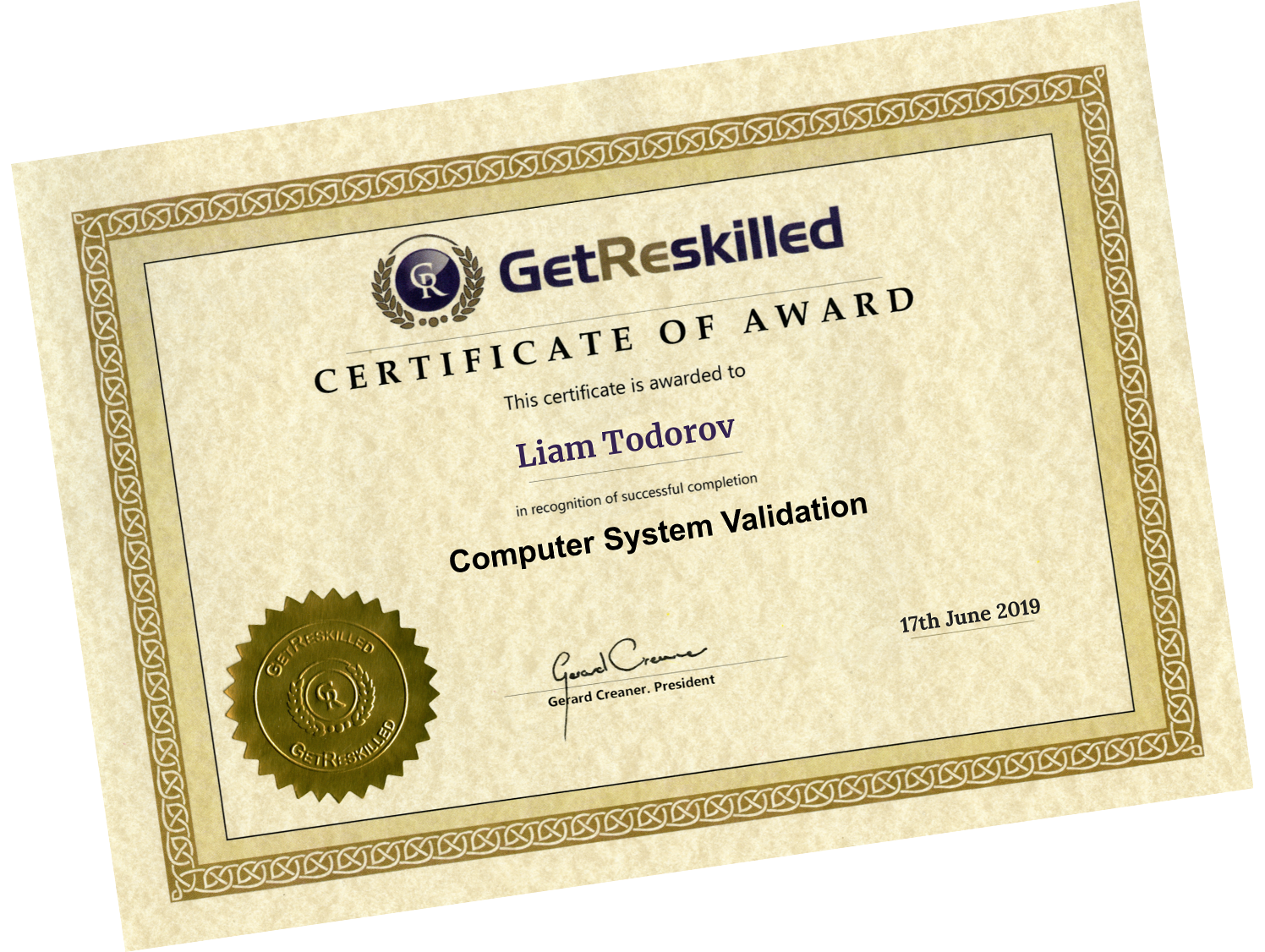Core content developed on a pharma construction project
This program was developed on-site by a team of senior chemical engineers, validation engineers, and automation engineers working within an engineering consultancy during the construction of a new pharmaceutical plant to train its own engineers and technicians.
You will write a 6,000-word technical report to present to senior management on a GxP computerized system application of your choice
Your report will help management make critical decisions about the electronic data generated and managed by the system, (e.g. will it meet the findings from a previous FDA/EMA audit, or to prepare for an upcoming audit, etc). And it will demonstrate:
- Your understanding of how the electronic data from the system is managed across the entire life cycle to make sure it is transparent, robust and tamperproof, that it is stored so that it stands the test of time.
- That the systems and procedures have been put in place to ensure that nothing crashes and no data is lost and that the necessary electronic records and electronic signatures (ERES) considerations have been included.
You can choose a project from work for this! You will outline the following:
- Identify and describe typical business and GMP functions
- Schematically represent typical architectural components
- Describe a general approach to achieving compliance and fitness for intended use over the entire lifecycle from:
- Concept
- Project
- Operation
- Retirement
Our CSV experts will give you written feedback on your report.
This Course is Right For You If…
Enroll in this course to learn…
- The key FDA and international regulations (EudraLex Volume 4 — Annex 11, ICH, WHO) and guidance regarding CSV and which apply to your company
- How the CSV process fits into your Software Life Cycle and the purpose of each validation deliverable
- The principles of your software quality assurance and how to manage the auditors’ expectations around its key components
- The software validation life cycle from design, through construction, installation and live start-up
- The regulations governing the use of electronic records and signatures in a regulated environment
- The methodology and implementation model for a risk-based approach to CSV
You’ll produce a number of deliverables throughout course including…
- Determine the end user supplier activities during the lifecycle of a computerized system
- Identify where you would use risk-based decision-making throughout the lifecycle of a computerized system
- Prepare a configuration management process flow diagram and identify where to use change control
- Define the content of typical logs and accompanying records for both incident management and corrective and preventive action (CAPA)
- Determine suitable risk controls when assessing electronic records and electronic signatures
- Complete 8-question booklets (one for every week’s worth of content) which will summarise what you have learnt for the week and ensure you retain and understand the information.
- Write a 6,000-word technical report to present to senior management on a GxP computerized system application of your choice.
And take the following skills and knowledge back to work…
- Be able to apply the FDA and international regulations to your current projects
- Use Risk based decision when making an assessment to see what software does or does not require validation, ensure critical risks are identified and the correct level of validation is carried out.
- Leverage risk-based decision making in your software quality assurance procedures
- Create key validation deliverables, including validation plans, requirements specifications, test plans, validation tests (IQ, OQ, PQ), trace matrices, test summaries, and validation reports
Course Price → FAQ
Entry Requirements
This program is highly specialized so you MUST have a solid understanding of GMP rules, regulations and guidelines.
AND you are any of the following…
- Validation Engineer/Specialist or Senior Validation Manager
- PhD, Masters or Degree in Biochemistry, Microbiology, Molecular Biology, Lab/Science, etc
- Automation, Control/Instrumentation, Process, Manufacturing, etc Engineer or Technician
- Quality Assurance or Quality Control Technician or Specialist
- Metrology, Maintenance Engineer, Technician or Specialist
- Front/Backend Developer
- Not sure if you meet the minimum requirements? Contact us.
NOTE: If you DON’T have a solid understanding of GMP rules, regulations and guidelines, you need to start with our 6-Week GMP Training For Beginners in the Pharmaceutical Industry. (There’s a special price reduction for this GMP program if taken together with our CSV course. Contact us for details)
What is Computer System Validation (CSV)?
Computer Systems Validation (CSV) is a process used to ensure (and document) that all computer-based systems will produce information or data that meet predefined requirements. If a system meets these requirements, it can be assumed that it is consistently performing in the way it was intended.
The process is used to replace paper with electronic data within highly regulated environments that directly impact public health and safety such as pharmaceutical and medical device manufacturing and make sure the system is:
- completely transparent, robust and tamper proof
- and can store those electronic data records so that they stand the test of time
What is a CSV Specialist?
CSV specialists plan, write, implement and review the Computer Systems Validation protocols in place within highly regulated manufacturing industries. Their work is essential to make sure that all computer-based systems are operating as intended (with documents to prove it) to meet regulatory requirements.
There is currently a high demand for trained Computer System Validation Specialists. As a result, salaries are highly competitive.
Need More Detailed Information?
What is Computer System Validation (CSV)?
What is a CSV Specialist?

Delivered by a Practicing Industry Expert
Dr. Joe Brady
Full-Time Validation Lead
Lecturer, Technological University Dublin, Ireland
Senior Associate, GetReskilled
Dr. Joe Brady is a full-time practicing Validation Lead and an assistant lecturer with Technological University Dublin (TU Dublin), in the School of Chemical and Pharmaceutical Sciences. Joe is a certified trainer and highly experienced in competency-based training. He designs and prepares educational modules and full academic courses ranging from MSc, MEngSc. BSc, to Certificate level, for a range of academic institution.
He is also a supervisor for MSc/MEngSc and PhD theses. Joe has over twenty years of project experience in the pharmaceutical, biopharmaceutical and medical device industries in Ireland, Singapore, China, The Netherlands, France and the USA.
Hear From People Who’ve Taken This Course

Ken O’Keeffe
“Interesting and Helpful in my Current Role”
“I have found the Computer System Validation course to be both interesting and helpful in my current role. The individual sections of the course are easy to follow. The delivery of the course is really straight forward. During the course there has been times when I have been busy with work and have not been able to study. The structure of the course allows me to be flexible in my study.”

Giorgia Romeo
“I Would Highly Recommend This Course”
“I would highly recommend anyone wishing to gain an education in the Computer System Validation sector to do this course. For me it has been very useful studying on-line in order to do the course in my own time. Lessons are very clear and the assignment deadlines make you disciplined to meet the deadlines set.”

John Ryan
“The Course Material is Concise and Interesting”
“The professionalism and passion of the lecturers comes across in the tutorials which gives the student confidence and encouragement to keep on top of the course. The course material is concise and interesting. The timing of the release of the lessons is perfect, the student moves at a comfortable pace, one step at a time.”
See Pricing →
If you’re spending money on an education program, make sure you choose one you’ll finish!
With every GetReskilled ONLINE program;
- We use one centralized platform (Moodle) where you can log into your classroom anytime. Each week, you’ll watch videos and complete a series of quizzes, tests, interactive activities, and projects. The course materials are available 24/7 and nothing requires you to be online at a specific day or time. i.e there are NO ZOOM classes and NO WEBINARS! Study anywhere, anytime, for example after the kids have gone to bed or on the weekend.
- Your working schedules are unpredictable so we offer flexible delivery. Slow down, speed up or pause the delivery of the program.
- We release only one week’s worth of material at a time and then MANUALLY check your activity logs at the end of every week to make sure that you are keeping up with your work.
- You’ll have a dedicated course leader who will email or telephone you if it looks like you’re starting to fall behind. They will work with you to develop a study plan to get you back on schedule and finish the course.
This all helps us to spot any potential issues early and helps you completely finish the program.

Start Your Application
Get certified and extend you or your team’s role to CSV Projects
Contact Details For This Course
Geraldine Creaner
Earn a Certificate of Award in “Computer Systems Validation”
Earn by successfully completing a 6,000-word technical report on a GxP computerized system application of your choice and get a Certificate of Award in Computer System Validation.
Add details of your certificate to your CV/Resume or your LinkedIn profile.

Price
$799/month
For 4 months
Or $2,899 in Advance
10 Day Fast Track Option
$3,999
- Complete this program in 10 days
- Your course leader will check your progress every morning and follow up with you to keep you on schedule.
- We can start you within 24 working hours upon receipt of payment.
- Contact us for details.
Group Price: Enroll a team of five people for the price of four. Save $2,899
€699/month
For 4 months
Or €2,699 in Advance
10 Day Fast Track Option
€3,999
- Complete this program in 10 days
- Your course leader will check your progress every morning and follow up with you to keep you on schedule.
- We can start you within 24 working hours upon receipt of payment.
- Contact us for details.
Group Price: Enroll a team of five people for the price of four. Save €2,699
£649/month
For 4 months
Or £2,299 in Advance
10 Day Fast Track Option
£3,499
- Complete this program in 10 days
- Your course leader will check your progress every morning and follow up with you to keep you on schedule.
- We can start you within 24 working hours upon receipt of payment.
- Contact us for details.
Group Price: Enroll a team of five people for the price of four. Save £2,299
Price
€699/month
For 4 months
Or €2,699 in Advance
10 Day Fast Track Option
€3,999
- Complete this program in 10 days
- Your course leader will check your progress every morning and follow up with you to keep you on schedule.
- We can start you within 24 working hours upon receipt of payment.
- Contact us for details.
Group Price: Enroll a team of five people for the price of four. Save €2,699
$799/month
For 4 months
Or $2,899 in Advance
10 Day Fast Track Option
$3,999
- Complete this program in 10 days
- Your course leader will check your progress every morning and follow up with you to keep you on schedule.
- We can start you within 24 working hours upon receipt of payment.
- Contact us for details.
Group Price: Enroll a team of five people for the price of four. Save $2,899
£649/month
For 4 months
Or £2,299 in Advance
10 Day Fast Track Option
£3,499
- Complete this program in 10 days
- Your course leader will check your progress every morning and follow up with you to keep you on schedule.
- We can start you within 24 working hours upon receipt of payment.
- Contact us for details.
Group Price: Enroll a team of five people for the price of four. Save £2,299
Price
£649/month
For 4 months
Or £2,299 in Advance
10 Day Fast Track Option
£3,499
- Complete this program in 10 days
- Your course leader will check your progress every morning and follow up with you to keep you on schedule.
- We can start you within 24 working hours upon receipt of payment.
- Contact us for details.
Group Price: Enroll a team of five people for the price of four. Save £2,299
€699/month
For 4 months
Or €2,699 in Advance
10 Day Fast Track Option
€3,999
- Complete this program in 10 days
- Your course leader will check your progress every morning and follow up with you to keep you on schedule.
- We can start you within 24 working hours upon receipt of payment.
- Contact us for details.
Group Price: Enroll a team of five people for the price of four. Save €2,699
$799/month
For 4 months
Or $2,899 in Advance
10 Day Fast Track Option
$3,999
- Complete this program in 10 days
- Your course leader will check your progress every morning and follow up with you to keep you on schedule.
- We can start you within 24 working hours upon receipt of payment.
- Contact us for details.
Group Price: Enroll a team of five people for the price of four. Save $2,899
Application Deadline: Wednesday 15th May
Program Starts: 23rd May
Can’t wait till the next Course Start Date? Request a “FAST” Start!
For an additional $500USD we can start you within 24 working hours.
Click here to “Request a “FAST” Start”
Start Your Application
Get certified and extend you or your team’s role to CSV Projects
Contact Details For This Course
Geraldine Creaner
Got More Questions?
Chat with us by clicking on the blue chat bubble in the bottom right corner of the page. We usually reply within a few minutes to a few hours.
Or fill out the form below and we’ll get back to you in one working day.


